| |
Riferimenti storici e geografici
The Croatian Language in Liturgy
A Historical Review of the Use and Development of the Croatian Language in Liturgy. Author: Anonymous (signed with initial V.). [Pagina originale].
| Indice |
Croatian belongs to the old liturgical languages of the church. This is of particular interest since it is known that Croatia has been under the jurisdiction of the Roman Bishop, the Pope, and therefore within the Western Church, where, ever since the 4th century, Latin had been known as the only official language used in liturgy until the Vatican II (October 11, 1962 - December 8, 1965) when national modern languages were allowed to be used in the liturgy.
In the Eastern Church, the question of the language to be used in liturgy has not been as "strict" as in the Western where the sacred rule was respected and only three languages (Latin, Greek and Hebrew) were allowed in liturgy, although only Latin was practically used.
The Vatican, in several instances, permitted the use of the native languages in liturgy; however, such exceptions (permits to practice Roman Rite in Armenian, Albanian, Georgian, Arabian and Chinese) were restricted to the Epistles and the Gospels. In the Christian East, following the decline of the Greek language (4th century), parallel to koine, the two Eastern liturgical families (Alexandrine and Antiochian) with some restrictions, used native languages in all pertaining rites.
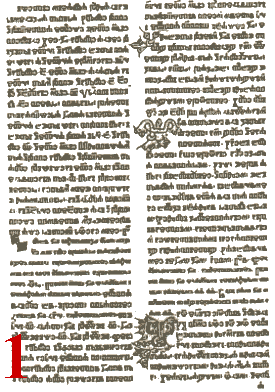
The first page of Croatian Glagolitic Missale Romanum dated February 22, 1483 -- possibly the first book published on Croatian soil.
At the time of the arrival of the Croats (during the 7th century), the present Croatian lands were under divided and alternating rules of the patriarchs of Constantinople and Rome. The coastal towns and islands were under the rule of the Byzantine patriarch, while the rest of Croatia was under the papal jurisdiction. In 1054, with the split between the Eastern and Western Churches, all Croatian lands came under papal jurisdiction.
There is yet another fact of significance to the Croatian lands with respect to the church and religion, especially language and liturgy.
Both Eastern and Western liturgies exerted their influences in Croatia what can be best seen by comparing liturgical texts that survived from the earlier and later dates. The period until 13th century is of the special significance. The liturgical and sacral influences of East and West have been important in the development and history of religious services in Croatia where both Eastern and Western rites were used simultaneously. That was reflected in liturgical texts and language and resulted in the recognition of the Croatian Rite, which in the 12th and 13th centuries became more and more a "Romano-Croatian rite" in the Croatian language. Yet another Croatian rite had developed in Latin, namely, the Zagrebian Rite. At the end of the 18th century it was abolished by Maksimilijan Vrhovac, Bishop of Zagreb, and replaced by the Roman Latin Rite. According to the results of the latest research on the basic codex of the Zagrebian liturgy, the Zagrebian Rite MR 165 (dated to the 11th century, written in "scriptura carolina") originated in Zadar, and not in Hungary as was previously thought. According to Archdeacon Ivan Goricki's testimony, even the first bishop of Zagreb, Duh (which is a Croatian surname) used Glagolitic alphabet. Nevertheless the Diocese of Zagreb (founded in 1094) became Latin because it was under the jurisdiction of the Archbishop of Ostrogon who imposed Latin exclusively on the liturgy. However, he was not successful in imposing the Roman Rite since a specific Zagrebian Rite was widely used in Northern Croatia. Thus, two languages (Latin and Croatian) have been used in liturgy within the Croatian lands with an alternating dominance of one or another according to historical and, mainly, political circumstances.

A page from the Bernardin Splicanin's Lectionary, printed in 1495.
We have no certain knowledge of the very first religious services in Croatian language. The oldest testimony to the use of the native Croatian language in liturgy dates back to 925 AD. In his letter to bishop Ivan of Solin and other bishops under his jurisdiction, Pope John X (914-928) expressed his concern for the wide spread use of Croatian language in liturgy. For that reason, at the Synods of Split during the 10th and 11th centuries (first Synod held in 925, fifth in 1075), there was a strong opposition towards the liturgy in native Croatian language and in favor of Latin. However, that did not prevent further development of the Croatian Glagolitic liturgy with particular Croatian and Croatian-Roman Rites.
The majority of historians believed that Croatian came into liturgical use as a direct legacy of St. Cyril and Methodius. It seems that such is not the case. Research into the topic has not been very intensive and much is left unknown, although some established facts point to the use of Croatian in liturgy prior to the Cyril-Methodian era (beginning of the second half of the 9th century). In their translations of liturgical texts taken to Moravia in 882 (on the invitation of Moravian prince Rastislav), Cyril and Metliodlus used Glagolitic characters. That is, probably, why the true Glagolitic alphabet has been attributed to the saint brothers, Cyril and Methodius, particularly St. Cyril. The true origin of the Glagolitic alphabet is not clear, but earlier evidence of the existence of the alphabet called "littera croatica," "littera illyrica," "littera slava" -- i.e., the Croatian alphabet, which was only in the 18th century to be called "glagolitic alphabet" (from Slavic glagolati = to talk, to speak) can be traced. Here is one of the examples. On January 10, 1955, in the ruins of the monastery of St. Mihovil at Rudina near Pozega, a brick having glagolitic inscription was found, thus supporting the theory that the glagolitic alphabet was of Croatian origin and that was, as one of the minor theories claims, brought by Croats from their ancestral homeland, somewhere in today's Iran. Also, the oldest surviving liturgical texts written in the, so called, Old Slavic language show faint signs of the Croatian origin of the texts that were used by St. Cyril and Methodius. Furthermore, the analysis of the biblical texts in the oldest Croatian glagolitic Missal, which was preserved in the Vatican's library, shows that they correspond to the oldest Latin translations of the Holy Bible, and thus Croatian translations should date prior to Charles the Great (813+). These two facts in the analysis of the oldest glagolitic liturgical codices, in addition to some other facts, mean that Croatians actually had some of the biblical and liturgical texts translated into Croatian prior to Cyril's and Methodius cultural activities among the Slavic nations. We should not forget that, at that time, the majority of Croatians were Christianized and therefore were not newly converted to the Christian faith at the time of St. Cyril and Methodius. Some questions remain: Which language and liturgical rite were in use in Croatia when St. Cyril and Methodius were active in Moravia? Who converted the Croats to Christianity? The last question is of importance to the liturgy -- the language and the rite in which religious services were conducted in Croatia. A reference should be made to the geographical position of the Croatian lands; the jurisdiction of the Church and her liturgical influences in Croatia -- the real influences of the East and West with everything that their religious concepts can contain or carry. The answers to the question of the Croatian conversion to Christianity and particularly the question of the origin of the Glagolitic alphabet are of a paramount importance in answering the question of the introduction of the Croatian language into liturgy. Unfortunately, only a few historical documents remained and very little is known that could help in resolving these complex questions.
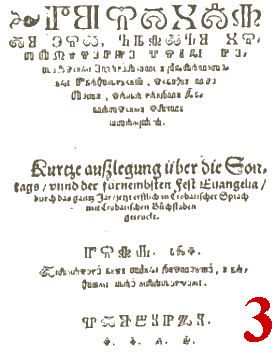
Glagolitic Protestant Postila, printed in Germany in 1562.
Yet another thought should be added here. If we should assume that both the Glagolitic alphabet and the liturgy in native language in Croatia could be attributed to the original work of St. Cyril and St. Methodius, we are still faced with the unanswered question of how their legacy reached Croatia. It does appear odd that the St. Cyril-Methodian liturgy could be so deeply rooted in Croatia where the church as well as the liturgical tradition and practice were already not so new. Actually, they were at least several decades old, even a century or two, or even more since it is possible that some of the Croats came to today's Croatia already Christianized. Anyway, there would have to be a definite reason for the holy brothers' legacy ("old Slavic" liturgy and Glagolitic alphabet) to be so quickly and deeply rooted in Croatia.
Researching old Croatian history is not an easy task. Many events were not recorded. The rare surviving documents and stone inscriptions have been decayed with age and destroyed during centuries of wars throughout the Croatian lands. Some of the written material and smaller monuments were frequently moved and transferred to a safe place never to be recovered again. For example, during the Mongol invasion (1242) some written documents from the Diocese of Zagreb and Kaptol were transferred to the Island of Rab and never returned. The transfer of documents and other historical sources from one place to another, one region to another has been a common practice especially under the threat of oncoming wars. It was already said that very little is known about the earliest periods of the liturgy in native language in Croatia, except for it being mentioned at the Synods of Split during the 10th and 11th centuries, the Pope's escort and chronicler, Baronius, noted that Pope Alexander III, was greeted by the Croats when he arrived in Zadar, in 1175, "immensis laudibus et canticis in eorum slavica lingua." Thus Baronius brought the testimony that Zadar, at the end of 12th century, had not only Latin, but also Croatian as a liturgical language.
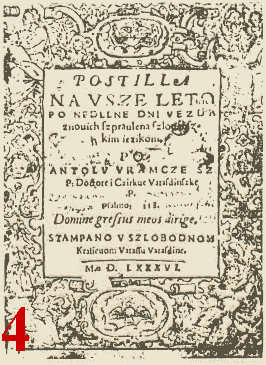
Antun Vramec's Postilla, printed in Varazdin in 1586.
The year 1248 was a turning point in the history of the Glagolitic liturgy. That year Pope Inocent III permitted Filip, Bishop of Senj, to use the native language in liturgy which was already the case in some other parts of Croatia. Several years later, in 1252, the same Pope authorized the Bishop of Krk, Fructuosus, to approve the local Benedictine friars' appeal to continue their practice of using Croatian in liturgy. A Venetian doge and chronographer, Giovanni Dandolo, testified that in 1350 Croatian was used in liturgy. Almost at the same time (second half of the 14th century), a Czech chronographer Pulkava wrote that, with papal permission, Croatian was used in many Croatian dioceses. According to J. de Thwrocz's work, Chronica Hungarorum, in Lipina, Diocese of Csanad, Hungary, Catholic priests were giving holy sacraments to the converted Slavs in "translation by St. Jerome," meaning the Croatian language. (Some time in the 13th century a "story" originated according to which St. Jerome was the author of Glagolitic liturgical translations. This would actually protect the Croatian Glagolitic liturgy for several centuries. It might be possible that there are some traces of truth in that story). In 1346, Pope Clement VIII issued a permit to the Croatian Glagolitic Benedictines who were invited by Charles IV, allowing them to establish a monastery in Ernaus, Bohemia, and use Croatian Glagolitic rite there.

Marko Andriolic's Pistule i Evanyelya from 1586 .
In the time-period from the 13th to the 15th century, the Croatian Glagolitic liturgy was widely used in Croatia, even in places where Latin was deeply rooted. The Glagolitic alphabet was used in Istria, Dalmatia, Lika and Krbava, in the most of Bosnia and in Slavonia. In the Diocese of Zagreb, where the Zagrebian rite and Latin language were used, glagolitic-Roman liturgy was being brought in by refugees from the south. Foreign governments, very often in agreement with foreign bishops and even with some domestic, were imposing Latin. Since the Turkish invasions of Croatian lands, the Glagolitic liturgy had been brought into the Diocese of Zagreb by refugees (during the 15th, 16th and 17th centuries). Between the 13th and 15th centuries, the Croatian-Roman rite spread to neighboring Carniola and to northern Albania. At the same time, Northern Croatia became distinctly Latin, while the glagolitic alphabet spread along the coast. This became even more obvious at the time of Ottoman invasions.
During the 13th century, Bosnian "glagoljasi" (priests who used Glagolitic liturgy) began to diverge from Croatian "glagoljasi," mainly because in Bosnia liturgical books were altered to conform to those from Rome. Later on the Franciscans became the true propagators of the Glagolitic liturgy. The development of the Glagolitic alphabet in Bosnia fell behind during the same period. The fragment of the Missal of Split, written in an archaic form of the Glagolitic alphabet at the beginning of the 13th century belongs to the renewed liturgical books. It is possible that the well known Bogomil question relates to the above mentioned liturgical "reformation."
Seventeen Glagolitic Missals dating back to the 14th and 15th centuries are known today. Most of them are regarded as art treasures because of the ornaments they contain, as for example Duke Novak's Missal (1368) which was used as the basic text to the first printed Croatian glagolitic Missal of 1483; duke Hrvoje's MissaI (beginning of 15th century); Missal of Vrbnik (1463) and others. Among them Missals of Vatican no.3, and no 4, Missal of Omisalj from the first quarter of the 14th century are considered to be the oldest ones.
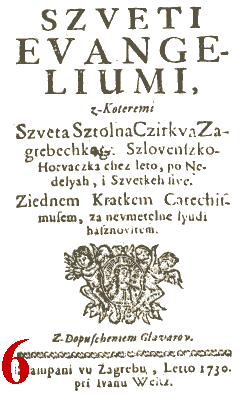
Title page of Szveti Evangeliumi printed in Zagreb in 1730.
More breviaries survived: A fragment of the Londonian Breviary, a fragment of the Vrbnik Breviary and the so called LIubIjana Homilies date back to the 13th century. European libraries cherish some 29 complete and partial Breviaries. Ten of them date back to the 14th century -- among them Vrbnik Breviaries II and IV, Lobkowicz's (1359), the Vatican Breviary (1379), Ljubljana and Vid Omisljanin's (1396). Among those surviving from the 15th century, the Draguc Breviary, dated 1407, is the oldest one.
Neither Venice during her long reign nor the Austro-Hungarian Empire appreciated the Glagolitic liturgy in Croatian lands. In 1481, for example, the Venetian government gave orders to their representative for the island of Krk to extradite Franciscan friars who were holding religious services according to Croatian liturgical customs ("more slavo") and to serve liturgy everywhere in Latin. Unfortunately, this was not an insolated case. There were rather few similar incidents in different parts of Croatia. The fight against the Glagolitic liturgy in Croatia had strong socio-political overtones. It was led by foreign governments who ruled over Croatian lands at certain times and were supported by some noblemen and high clergy. Rome was frequently visited by those presenting claims against Croatian Glagolitic liturgy. Rome's response either for or against depended upon the historical moment and the manner in which the claim was presented. Indeed, the Croatian Glagolitic liturgy was often maligned as being heretical as was the case even in the last century.
Gutenberg's invention was accepted and applied in Croatia very early. The first printed book in Croatian, "Missale Romanum," was published on February 22nd, 1483. That cultural event of paramount importance in Croatian history happened at the very moment when the Croatian Glagolitic liturgy achieved its "golden era." Already in those early years of the invention of the printing technique, several valuable works were produced in Croatia although the political climate was not favorable. The Croatian nation was at that time "existentially threatened by the East, politically suppressed by the North; Croatian culture and heritage have been denied by the South and the West."
The first printed book from 1483 still is the greatest achievement of all glagolitic printed books. It was printed somewhere in Croatia, probably in Kosinj, Lika. Soon afterwards in Senj, as well as in Rijeka, new printing houses were established and liturgical books published: Missals, Breviaries including parts of the Ritual (baptism, marriage and other sacraments as well as other appropriate blessings, some of which present the original rites).

A page from Kajkavian Suffering and Death of Christ According to Matthew, from 1799.
During the several decades following the first printed hook in Croatian (Missal 1483), at least seven editions of the Croatian glagolitic Missal were printed, mainly on Croatian territory: "Baromic's Missal" (Senj, 1494), "Bedricic's Missal" (Senj, 1507), Pavao Modrusanin's (Venice, 1528), "Kozicic's Missal" (Rijeka, 1531), "De Dominis' Missal" (Rijeka, 1540), and "Brozovic's Missal" (Venice, 1561). Among Breviaries, "Baromic's Breviary" printed in Seni in March of 1493 is the oldest. Ritual has been added to that book. In March of 1561, Mikula Brozic's Breviary was printed in Venice. It has since been reprinted several times.
The decline of the Glagolitic liturgy began in the 16th century as a result of the hard political situation and of constant wars against the Ottomans who, at the time, occupied a large part of Croatian territory. On the other hand, Venice exerted steady political pressure on Dalmatia. There were also the aftereffects of Protestantism and the Council of Trident. Some bishops were foreigners and many Croatian clergymen were not sufficiently educated. It was a time of the gap between church language and spoken Croatian. Rafael Levakovic's Missal from 1631 shows the decline of glagoljica. Three years prior to that edition, in 1628, Rafael Levakovic published Nauk Krstjanski (in Rome) written in proper spoken Croatian and in the glagolitic alphabet. However, in the following year he fell under the influence of the Russian uniats who misled him into rewriting the Missal according to the rules of the Russian variant of the Church language, which was in many ways similar to the Old Slavic language, with the characteristics of the Cakavian dialect. The language of the Croatian glagolitic liturgy was even further distorted when later, together with Little Russian (Ukrainian) bishop Matija Terlecki, Levakovic prepared a new breviary. This interrupted the centuries long continuous development of the church language which was so carefully cultivated by glagoljasi. The "russification" was even more strongly reinforced in Matej Karaman's Missal from 1741, which, like the Levakovic's Missal, was printed in the "De Propaganda Fide" printing house. The fact that the language was not understood led to the failure of russification. Fortunately, Levakovic was not successful in his attempt to publish the grammar of his russified language. The Congregatio de Propaganda Fide in Rome hoped that the "russification" of the liturgical language in Croatia would help the unification of Eastern and Western Church among nations speaking Slavic languages. This policy was based on insufficient knowledge of the language developments among Slavic nations and the language situation in Croatia. Moreover, in Croatia, it resulted in conflict and polemics among the clergy: while Matej Karaman, Archbishop of Zadar, maintained that "russification" is important and useful, he was strongly opposed by Stiepan Rusic, a priest from Dubrovnik, who insisted that the language used in the liturgy should be spoken Croatian. A compromise position was taken by Pope Benedict XIV in his encyclical letter "Ex pastorali munere" issued on August 15, 1754 by which the "russification" was confirmed, but the glagolitic liturgy, with a limited use, was also approved.
From the end of the 18th century to the beginning of the 20th there was a revived interest in the Croatian glagolitic liturgy which led to continuous purification of "russified" texts. This culminated in the publication of a new glagolitic Missal, printed in Rome in 1893, which was free of all "russifications." Though Pope Leon XIII was favorably inclined towards the "glagoljasi", the political situation in the Austro-Hungarian Empire was unpropitious for continuation of the glagolitic liturgy in Croatian lands. This liturgy was somewhat strengthened by the establishment of the seminaries in Priko near Omis and in Zadar. Nevertheless, the "Old Slavonic", i.e., old Croatian language in the liturgy struggled for its survival during the 19th and at the beginning of this century. After World War I the glagolitic liturgy entered a peaceful period that lasted until Vatican II, when it influenced the decision of the Council Fathers to accept the liturgy in common, spoken languages of all nations.
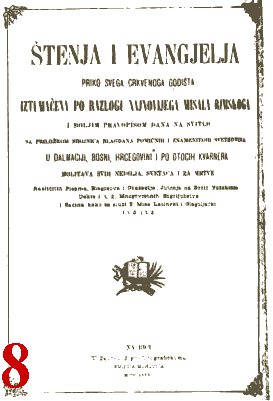
The last edition of Scavet, printed in Rijeka in 1880.
In the second decade of this century, glagolitic alphabet in liturgy was replaced by the Latin alphabet. In 1927, Jozef Vajs' Missal was published in Rome. With the exception of the Canon, it was printed in the Latin alphabet, but in the old language which was far removed from the common spoken Croatian.
In Croatia, liturgical books have been printed in the Latin alphabet since the end of the 15th century. (However, the glagolitic alphabet was prevalent). The first such book was the Evangelistarium (Gospel Book), printed in Venice in 1495, to be used in churches using Latin in their liturgy. It was the custom in Croatia that the Epistles and Gospel were read in Croatian. Therefore, within the glagolitic epoque that lasted more than eleven centuries, there was a six centuries long legacy of Croatian lectionaries. The glagoljica gave way to the Latin alphabet just as the other two alphabets used in Croatian at that time did. In addition to the glagolitic alphabet the Cyrillic alphabet (bosancica) and, in the Croatian lands under Turkish occupation, the Arabic script were in use. It is not known whether anything concerning the Catholic liturgy was written in the Arabic script. "Bosancica" was used in some of the liturgical books and prayer books, the oldest known "Dubrovnik Prayer Book" dating back to 1512. Officium of Blessed Virgin Mary was included in the book, and in the second edition (1571 fifteen prayers of St. Bridget were added.
During the last several decades of the existence of the Roman-Croatian liturgy, the Roman-rite in Old Croatian, even the spoken common language was introduced with the approval of the Holy See. In 1929, the Croatian Ritual and the Croatian lectionary were printed after being approved in Rome. This was only the legalization of a centuries-long tradition. Shortly after the Roman Ritual was issued by Pope Paul V in 1614, the Croatian language version of the Ritual with a dedication to Pope Urban VIII was printed in 1640 in Rome by the Congregatio de Propaganda Fide. The same Croatian ritual was subsequently published in Venice in 1827 and again in 1893. There are numerous proofs of the usage of the native language in various Catholic Church rites in Croatia from the earliest times as indicated in notes and addenda contained in many Missals and Breviaries.
We already mentioned the several centuries long legacy of the Croatian Lectionaries that reflect in their language the locality where and the historical moment when they were printed or translated. In reality, throughout the whole history of Croatia, the native language was present in the liturgy. Although the language of the Missals and Breviaries is called "Old Slavic", it actually is Croatian for it follows the linguistic development of the Croatian language. The older the texts, the more similar is the language to the other Slavic languages. With time the language of the Missals and Officia was altered according to the linguistic development of the historical period it was written in. Texts once translated were only adapted to the time and local circumstances rather than completely altered. These texts, from the Vienna Folia (12th century) on, retain elements common to all Slavic liturgistic texts, which in Croatia gradually lose the Old Slavic linguistic characteristics, especially nasal phonems. Little by little some graphic groups, syntax and lexemes changed in accordance with the development of the Croatian language. However, many features depended on the copyist or translator and his knowledge and language feeling. It also often depended on the copyist's desire to make his language as understandable as possible for the people of his locality. In the beginning, the liturgical and spoken native language of Croatia developed parallel to each other, but in time the development of the liturgical language fell behind. The final split appeared with the russification of the Croatian liturgy. The purification of liturgical language was fruitless. With its victory, Croatian liturgical language became more and more lifeless.
At the time of discord between liturgical and vernacular language in Croatia and due to the lack of knowledge of the glagolitic script by clergy, so called "scavet" appeared. It substituted for the old Croatian that carried some characteristics of the Old Slavic, the spoken Croatian, and glagolitic script with Latin. "Scavet" appeared at the end of 15th century and lasted until recently. At the beginning "Scavet" contained biblical readings and other rites, but from the 17th century it contained all parts of the Holy Mass spoken by the priest and the common people. "Scavet" was used mainly in Latin churches because the common people did not understand Latin in liturgy, and, in glagolitic churches in the beginning due to the lack of needed liturgical books in glagolitic alphabet, and later because of the russification.
What is nowadays common to the Western church has been happening in Croatia through many centuries. Liturgy was performed in common folk language: mass, officia, baptizing, marriage and other sacraments as well as other religious rites. Therefore, Croatian is one of the liturgical languages in the Catholic, and therefore Western church, almost exclusively used in conjunction with Latin through several centuries. Liturgical books, actually different fragments of liturgical texts, are the oldest Croatian written works and books. Glagolitic literacy in Croatia is the oldest and very rich. Due to Croatian glagolitic liturgy, the Croatian language had solid foundations and supported an artistic literature that has existed for full five centuries. Out of liturgical texts in Croatian language, the richest are those written in the glagolitic alphabet followed by those written in Latin characters, followed by bosancica, while the fourth script used in Croatian language, Arabic, was probably not used in liturgy. In the history of liturgy, the development of the liturgy in Croatia is very interesting because of its specific Croatian and Romano-Croatian rites.
Illustrations:
- The first page of Croatian Glagolitic Missale Romanum dated February 22, 1483 -- possibly the first book published on Croatian soil.
- A page from the Bernardin Splicanin's Lectionary, printed in 1495.
- Glagolitic Protestant Postila, printed in Germany in 1562.
- Antun Vramec's Postilla, printed in Varazdin in 1586.
- Marko Andriolic's Pistule i Evanyelya from 1586.
- Title page of Szveti Evangeliumi printed in Zagreb in 1730.
- A page from Kajkavian Suffering and Death of Christ According to Matthew, from 1799.
- The last edition of Scavet, printed in Rijeka in 1880.
|







